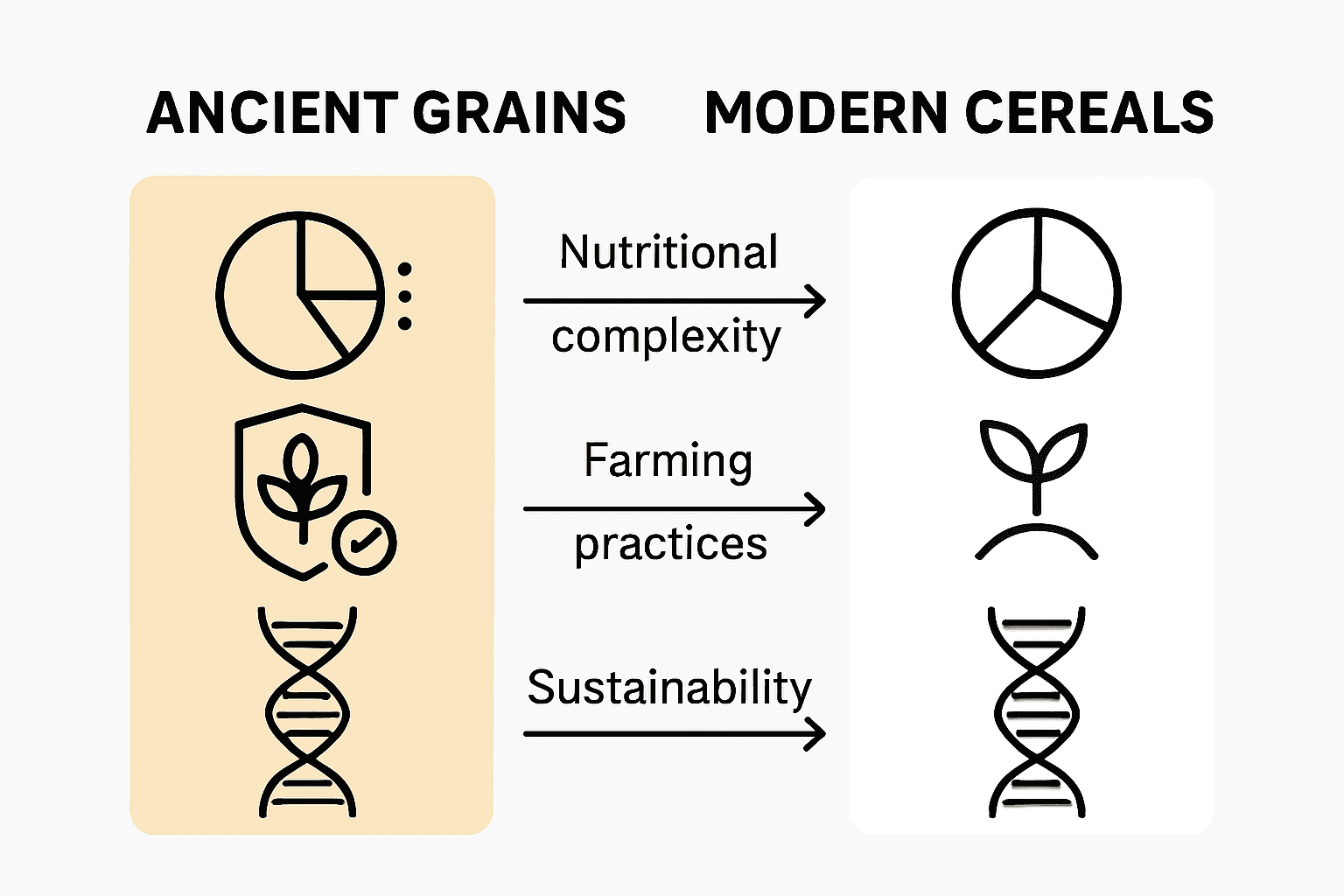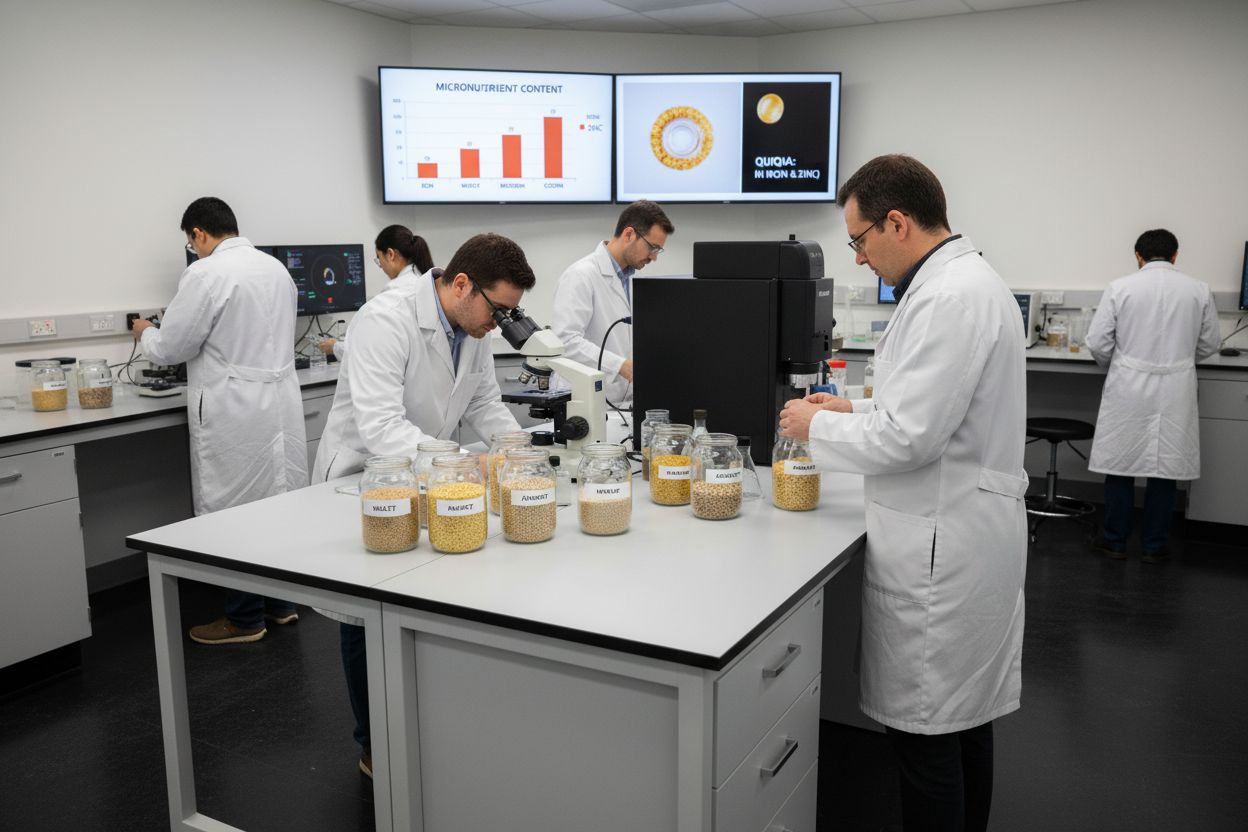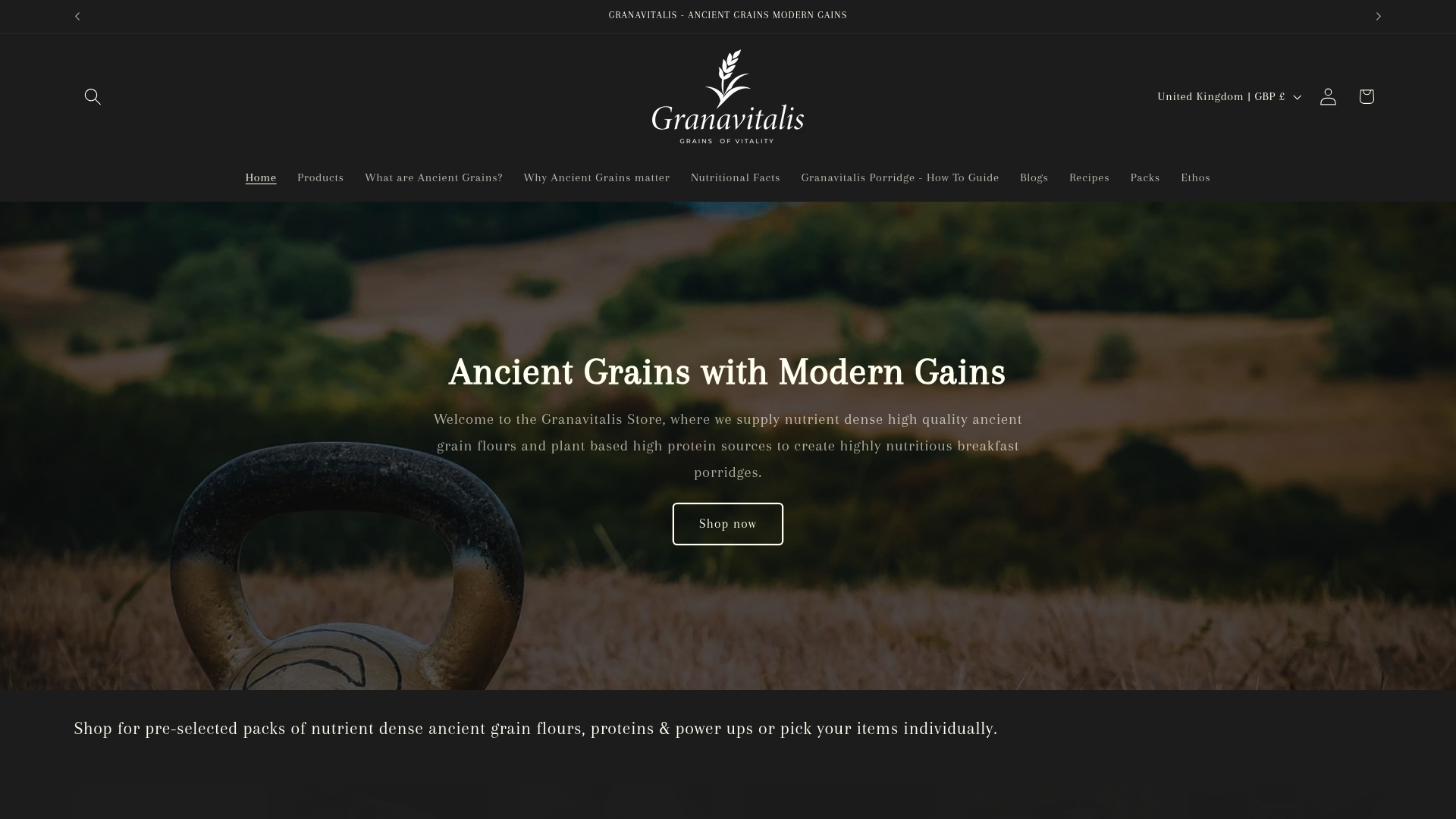
Ancient Grains vs Modern Cereals Explained: Benefits & Differences
Share
Did you know that over 70 percent of the world’s daily calories come from cereal grains like wheat, rice, and corn? These humble staples sit at the core of our diets, shaping everything from breakfast tables to global food security. Understanding the differences between time-honored ancient grains and today’s modern cereals can help you find more nourishment, better flavor, and a stronger connection to the foods that fuel you every day.
Table of Contents
- Ancient Grains and Modern Cereals Defined
- Nutritional Profiles of Grains and Cereals
- Health Benefits and Dietary Impacts
- Sourcing, Processing, and Sustainability Issues
- Choosing the Best Option for Breakfasts
Key Takeaways
| Point | Details |
|---|---|
| Nutritional Superiority of Ancient Grains | Ancient grains provide a more complex nutritional profile, offering higher levels of micronutrients, protein diversity, and fiber compared to modern cereals. |
| Impact of Agricultural Practices | Modern cereals often suffer from reduced nutritional quality due to intensive farming techniques, making a case for reintroducing traditional grains for health benefits. |
| Health Benefits | Incorporating ancient grains into the diet can support digestive health, stabilize blood sugar levels, and enhance overall wellness. |
| Sustainability and Resilience | Ancient grain varieties typically require fewer resources to grow, making them more environmentally sustainable compared to their modern counterparts. |
Ancient Grains and Modern Cereals Defined
Cereals have been fundamental to human nutrition for millennia, with archaeological evidence revealing their profound significance across civilisations. According to research from archaeological sites, grains like barley, wheat, and oats have consistently been primary food sources throughout human history. These versatile crops represent two distinct categories: ancient grains and modern cereals, each with unique nutritional profiles and agricultural characteristics.

Here’s a comparison of ancient grains and modern cereals:
| Feature | Ancient Grains | Modern Cereals |
|---|---|---|
| Examples | Quinoa Amaranth Millet Spelt |
Wheat (modern) Corn Rice |
| Genetic Modification | Minimal Traditional breeding |
Extensive Selective breeding |
| Nutritional Density | Higher micronutrients More fibre |
Often reduced Loss of diversity |
| Protein Complexity | Greater variety | Standardised Uniform |
| Environmental Resilience | High Adaptable |
Reliant on intensive inputs |
| Yield | Lower, more diverse | Higher, standardised |
Ancient grains are traditional grain varieties that have remained largely unchanged through selective breeding, preserving their original genetic structures. Examples include quinoa, amaranth, millet, and spelt - crops that have sustained human populations for thousands of years. In contrast, modern cereals are contemporary grain varieties developed through intensive agricultural techniques and genetic modifications, prioritising characteristics like higher yield, pest resistance, and uniform appearance.
The primary distinction between these grain categories lies in their nutritional complexity. Understanding why choose ancient grains for health reveals that ancient grains typically contain higher micronutrient densities, more diverse protein structures, and greater fibre content compared to modern, industrially processed cereals. Modern wheat and corn, for instance, have been significantly altered from their ancestral counterparts, often losing nutritional depth in pursuit of agricultural efficiency.
From an agricultural perspective, cereals represent some of the most widely cultivated crops globally. Research indicates that primary staple grains include wheat, rice, corn, sorghum, barley, oats, and millet - each playing a crucial role in worldwide food systems. The journey from ancient to modern grains reflects humanity’s complex relationship with agriculture, nutrition, and technological advancement.
Nutritional Profiles of Grains and Cereals
The nutritional landscape of grains has undergone significant transformations, with modern agricultural practices dramatically influencing their micronutrient composition. Research from agricultural studies reveals a compelling narrative about grain nutrition. According to findings published by UK agricultural research, while grain yields have increased over time, the concentrations of essential minerals have paradoxically decreased in modern wheat cultivars.
Mineral Content has become a critical point of concern for nutritionists and agricultural researchers. Studies indicate that contemporary wheat varieties exhibit lower concentrations of vital minerals compared to their historical counterparts. Understanding how ancient grains support wellness naturally highlights the nutritional superiority of traditional grain varieties that maintain a more complex and diverse mineral profile.
Biofortification represents a modern approach to addressing nutritional gaps. Research on bread wheat genotypes demonstrates intricate variations in protein content, gluten quantity, and other nutritional parameters. Researchers are actively exploring strategies to enhance the nutritional value of grains, recognizing the critical role these staple foods play in global nutrition.
The nutritional profile of grains extends beyond simple macronutrient measurements. Ancient grains typically offer a more comprehensive nutritional package, featuring higher levels of protein diversity, trace minerals, and beneficial compounds. Modern cereals, while optimized for yield and agricultural efficiency, often sacrifice nutritional complexity in the process. This evolutionary trajectory of grain nutrition underscores the importance of understanding the profound changes in our food systems and the potential benefits of returning to more traditional, nutrient-dense grain varieties.

Health Benefits and Dietary Impacts
The potential health benefits of ancient grains extend far beyond their nutritional complexity, offering promising insights into dietary wellness. According to research from academic studies, ancient wheat varieties demonstrate unique physiological responses that distinguish them from modern bread wheat varieties. These findings suggest a nuanced relationship between grain selection and overall health outcomes.
Physiological Responses to grain consumption reveal intriguing patterns. Understanding ancient grains and gut health explores how different grain types interact with our metabolic systems. Studies examining porridges made from ancient grains like millets have shown physiological responses remarkably similar to common Western grain varieties, indicating potential alternative nutritional pathways that might support digestive and metabolic health.
Researchers are particularly interested in the subtle yet significant differences between ancient and modern grains. While mechanisms remain partially unclear, emerging evidence suggests that traditional grain varieties may offer unique protective qualities. These grains potentially provide more complex nutritional profiles that support immune function, metabolic regulation, and long-term wellness. The diversity of ancient grains - including varieties like quinoa, amaranth, and millet - presents a rich tapestry of potential health benefits waiting to be fully understood.
Beyond individual nutritional characteristics, the broader dietary impact of ancient grains represents a holistic approach to nutrition. By reintroducing these traditional grain varieties into modern diets, individuals may unlock potential benefits ranging from improved digestive health to more stable blood sugar responses. The journey of understanding ancient grains is not just about nutritional analysis, but about reconnecting with time-tested dietary wisdom that has sustained human populations for millennia.
Sourcing, Processing, and Sustainability Issues
The landscape of grain production has become increasingly complex, balancing nutritional needs with agricultural sustainability. Modern cereal varieties have been engineered to maximize yield, but this approach has raised significant concerns about long-term nutritional quality and environmental impact. Research indicates that while agricultural productivity has increased, the micronutrient content of grains has simultaneously diminished.
Biofortification has emerged as a critical strategy to address these nutritional challenges. Understanding ancient grains explained for better health highlights innovative approaches to enhancing grain nutrition. Researchers are actively developing wheat varieties with improved iron and zinc content, aiming to combat global micronutrient deficiencies through targeted agricultural interventions. These efforts represent a sophisticated approach to addressing nutritional gaps in our food systems.
Sustainability considerations extend beyond nutritional content, encompassing broader environmental and agricultural practices. Ancient grain varieties often demonstrate remarkable resilience, requiring fewer chemical inputs and showing greater adaptability to diverse growing conditions. This natural resistance contrasts with modern cereals, which frequently depend on intensive farming techniques that can deplete soil health and increase environmental stress.
The sourcing of grains has become a complex intersection of agricultural science, nutritional research, and environmental stewardship. By reimagining our approach to grain production - prioritizing nutrient density, ecological balance, and genetic diversity - we can develop more sustainable food systems. The future of grain production lies not in maximizing yield at all costs, but in creating a holistic approach that nurtures both human health and environmental well-being.
Choosing the Best Option for Breakfasts
Breakfast represents a critical opportunity to nourish our bodies and set a nutritional foundation for the day ahead. Health recommendations consistently emphasize the importance of whole grains, with dietary guidelines suggesting adults consume at least three servings of wholegrains daily. This can include a diverse range of options like porridge oats, muesli, and wholegrain bread, each offering unique nutritional profiles.
Porridge emerges as an exceptional breakfast choice, particularly when crafted from ancient grain varieties. How to make high-protein porridge naturally highlights the versatility of these nutritional powerhouses. Research examining breakfast porridges made from ancient grains like millets reveals physiological responses remarkably similar to common Western grain varieties, indicating these traditional options are not just nutritionally comparable but potentially superior.
When selecting breakfast grains, consider factors beyond simple taste and convenience. Ancient grains such as quinoa, amaranth, and millet offer complex nutritional landscapes - providing higher protein content, more diverse micronutrients, and enhanced digestibility compared to processed modern cereals. These grains represent more than just a meal; they’re a connection to nutritional traditions that have sustained human populations for millennia.
Ultimately, the best breakfast grain is one that balances nutritional density, personal taste preferences, and dietary requirements. By exploring ancient grain options, individuals can transform their morning meal from a mundane routine into a powerful nutritional strategy. The key is experimentation, understanding individual nutritional needs, and embracing the rich diversity of grain varieties available.
Rediscover the Power of Ancient Grains for a Healthier Breakfast
If you’ve been searching for a way to replace modern cereals that often lack in nutrition and rely on intensive farming methods, embracing ancient grains could be your solution. These traditional grains bring higher micronutrients, diverse protein profiles, and natural fibre back to your table. At Granavitalis, we understand the challenges of finding wholesome breakfast options that truly nourish your body and support long-term wellbeing.
Experience the benefits of ancient grains paired with high-quality protein by exploring our selection of All Flours and Protein Power Packs. Each product is thoughtfully chosen to reconnect you with nutrient-dense foods rooted in tradition and nature.

Transform your mornings today with carefully crafted, nourishing meals that give you energy and resilience. Visit Granavitalis and discover how easy it can be to switch from nutrient-poor modern cereals to ancient grains designed to fuel your health. Your body and future self will thank you.
Frequently Asked Questions
What are ancient grains and how do they differ from modern cereals?
Ancient grains are traditional grain varieties that have remained largely unchanged through selective breeding, such as quinoa, amaranth, and millet. Modern cereals, like contemporary wheat and corn, have been developed through intensive agricultural techniques and genetic modifications, leading to higher yields but often lower nutritional complexity.
What are the nutritional benefits of ancient grains compared to modern cereals?
Ancient grains typically offer higher levels of micronutrients, protein diversity, and dietary fiber. In contrast, modern cereals often have reduced nutritional profiles due to extensive processing and selective breeding focused on yield rather than nutritional density.
How can ancient grains impact gut health?
Research suggests that ancient grains may provide unique physiological benefits, such as improved digestive health. Their complex nutritional profiles and higher fiber content can support metabolism and gut function, potentially leading to better overall health outcomes.
Why should I consider incorporating ancient grains into my breakfast?
Incorporating ancient grains into your breakfast can enhance your nutrient intake, offering benefits like higher protein content and more diverse micronutrients. They serve as a wholesome alternative to processed cereals, promoting sustained energy and better digestion throughout the day.
